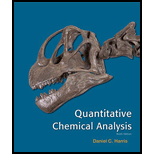
a)
Interpretation:
A graph has to be plotted using a spreadsheet representing the mass of analyte extracted into fibre.
Concept Introduction:
Solid-phase microextraction:
The extraction of compounds from liquids, air or sludge without any solvent is called as solid-phase microextraction. The major component is the fused-silica fibre coated with
The mass of analyte absorbed in the coated fibre is calculated using the formula,
Where
To plot a graph showing the extracted mass (vs) volume of the solution
b)
Interpretation:
The limit of
Concept Introduction:
Solid-phase microextraction:
The extraction of compounds from liquids, air or sludge without any solvent is called as solid-phase microextraction. The major component is the fused-silica fibre coated with
The mass of analyte absorbed in the coated fibre is calculated using the formula,
Where
To estimate the limit of
c)
Interpretation:
The percentage of the analyte from 100 ml of solution is extracted if K=100 and K=10000 has to be calculated.
To calculate the percentage of the analyte from 100 ml of solution is extracted if K=100 and K=10000
Want to see the full answer?
Check out a sample textbook solution
Chapter 24 Solutions
Quantitative Chemical Analysis
 ChemistryChemistryISBN:9781305957404Author:Steven S. Zumdahl, Susan A. Zumdahl, Donald J. DeCostePublisher:Cengage Learning
ChemistryChemistryISBN:9781305957404Author:Steven S. Zumdahl, Susan A. Zumdahl, Donald J. DeCostePublisher:Cengage Learning ChemistryChemistryISBN:9781259911156Author:Raymond Chang Dr., Jason Overby ProfessorPublisher:McGraw-Hill Education
ChemistryChemistryISBN:9781259911156Author:Raymond Chang Dr., Jason Overby ProfessorPublisher:McGraw-Hill Education Principles of Instrumental AnalysisChemistryISBN:9781305577213Author:Douglas A. Skoog, F. James Holler, Stanley R. CrouchPublisher:Cengage Learning
Principles of Instrumental AnalysisChemistryISBN:9781305577213Author:Douglas A. Skoog, F. James Holler, Stanley R. CrouchPublisher:Cengage Learning Organic ChemistryChemistryISBN:9780078021558Author:Janice Gorzynski Smith Dr.Publisher:McGraw-Hill Education
Organic ChemistryChemistryISBN:9780078021558Author:Janice Gorzynski Smith Dr.Publisher:McGraw-Hill Education Chemistry: Principles and ReactionsChemistryISBN:9781305079373Author:William L. Masterton, Cecile N. HurleyPublisher:Cengage Learning
Chemistry: Principles and ReactionsChemistryISBN:9781305079373Author:William L. Masterton, Cecile N. HurleyPublisher:Cengage Learning Elementary Principles of Chemical Processes, Bind...ChemistryISBN:9781118431221Author:Richard M. Felder, Ronald W. Rousseau, Lisa G. BullardPublisher:WILEY
Elementary Principles of Chemical Processes, Bind...ChemistryISBN:9781118431221Author:Richard M. Felder, Ronald W. Rousseau, Lisa G. BullardPublisher:WILEY





